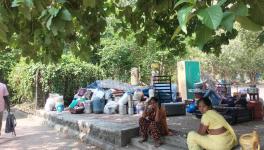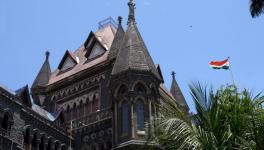How many “Natural Disasters” Until the Govt Takes Notice of Ambedkar Nagar Residents?
Image Courtesy:mumbaimirror.indiatimes.com
Around 10 to 15 makeshift shelters in Malad’s Ambedkar Nagar were swept away between May 16 and May 17, 2021 during the onslaught of cyclone Tauktae in Mumbai. To residents like Anish Yadav, this was more inevitable than a tragedy, considering the sham of plastic sheets and bamboo sticks that passed as houses in the area.
Already, on the night of July 1, 2019, Ambedkar Nagar and Pimpripada communities lost at least 140 such shelters after a 2.3 km long boundary wall collapsed onto the settlement. Nearly 86 survivors were moved to sturdy houses after the incident, said Yadav.
They were the lucky few who availed a rehabilitation that the community has been waiting for since 1997. Others remain in the same danger zone answering routine questions for Brihanmumbai Municipal Corporation (BMC) surveys.
“After the cyclone, some BMC officials came for yet another survey. We receive no other communication from them about the court order that assured us rehabilitation years ago. We are left to check when the water will reach us during monsoon. The situation is bad. Nobody can imagine that such a thing is happening in Mumbai. We don’t know where else to go,” said Yadav.
He referred to the Bombay High Court judgement on May 7, 1997. At the time, Chief Justice M. B. Shah and Justice F. J Rebello ordered that slum dwellers in the National Park Division, who were registered on electoral rolls prepared on or before January 1, 1995, should be moved to proper houses within 18 months.
Yet, the area remained neglected until the wall constructed by the Municipal Corporation of Greater Mumbai (MCGM) to protect a nearby reservoir killed tens of people. The incident was termed as a natural disaster by officials. However, the continued neglect by state officials even after the recent cyclone speaks to an allegation in the “Malad Wall Collapse: A State Induced Disaster” interim report of 2019 that the breach was not “natural” but the result of an exclusionary move by a negligent administration.
What is the exclusionary move?
The report by various civil society organisations, including the Ghar Bachao Ghar Banao Andolan that first demanded rehabilitation of residents, said that the wall built was meant to be a visual and physical barrier i.e., a compound wall and not a retaining wall. The former is not designed to resist lateral pressure of the soil when the ground level is changed on different sides of the wall.
The wall in question did not have deep foundations, nor did it widen at the base like a retaining wall. It also did not have holes to release the built-up water pressure but a culvert under the asphalt that worsened the situation.
“If the protection of the property from informal settlements was the purpose of the wall, a mesh wire fence mounted on a retaining wall would have served both purposes (allowing road construction as well as protecting the property),” said the report.
The fact-finding team said that the true purpose of the wall was not to build a road for the reservoir facility or prevent occupation of public land but to rid the land and its facilities above from the sight and presence of the poor.
“Like all similar walls built in cities around the world, it is a symptom of a divided city, and the embodiment of apathy and contempt towards an excluded population. The 4-meter-high concrete wall was a device to shut out of sight and contain dwellers, and little else,” said the report.
The team said that such exclusionary objectives resulted in little attention to site conditions, design details and structural requirements. They condemned the system on four fronts:
- Failure to provide safe living environments to communities in precarious conditions
- Discriminatory practices indulging vanity projects as opposed to basic facilities
- Failure to maintain essential public services
- Absence of any post-disaster response and recovery programs
Aftermath of “natural disasters”
As many as 29 people died that year after the breach and resulting flood in 2019. Locals claim that the number may be higher as many families are still in hospital and several people are still unaccounted for. Around 130 people suffered a range of injuries from contusions, abrasions, lacerations, fractures, joint dislocations and concussions to internal injuries, resulting in acute body pain.
Further, 140 to 160 houses in Ambedkar Nagar and around 65 houses in Pimpripada were flattened. Around 80 to 95 houses of the two places were flooded and sustained extensive damage. All of this added to the damage after Cyclone Tauktae wherein once again, make-shift houses were torn apart. Yadav said that even children prefer to stay in the open nowadays, fearing that their makeshift home will crumble any moment.
Yadav asked, “Little kids go to the playground because they’re scared the house will fall on them. Water goes straight into the houses. Rains are our biggest fear. What about kids? What if they get in an accident?”
The ruin of personal property is all the more devastating for informal sector workers. The settlement shelters construction workers, welders, nurses and nursing assistants, hospitality staff and domestic workers among others.
Their everyday life was upended because many “did not have any clothes to wear outside.” Others lost all documents and possessions. Already, the community has no monthly postage of light bills owing to the illegal means of light and water supply. There are just enough documents to create a vote bank, said Yadav.
The report said that calling an event with such devastating consequences a ‘natural disaster’ overlooks all formative circumstances and nature of response that makes it a ‘disaster.’
“It is a standard tactic adopted by authorities to deflect attention from the failures of social policy, and blame it on ‘natural’ causes. It becomes a convenient excuse to overlook the arduous and exacting process of rebuilding lives from shock and devastation which victims have to piece together, often on their own,” said the report.
Measures required:
In another court order after the High Court decision, eligible residents paid rehabilitation fees of Rs. 7,000. Accordingly, rehabilitation including temporary relief like basic amenities should be the primary move of the state government to correct a 24-year-long wrong. Basic amenities should also ensure that residents avail proper electricity and water supply until rehabilitation for the correct prices. Locals told the fact-finding team that they pay between Rs 14 to Rs 17 per unit of electricity.
Moreover, aggrieved families should receive a compensation of Rs. 5 lakhs. As per the report, eleven people received Rs. 4 lakhs as a ‘first instalment’ with the remaining 1 lakh to be received after verification of relevant documents. Cash compensation should also cover medical expenses, living expenses, school fees and their economic loss, said the report.
Other aspects to be considered are recovery of documents, medical support including mental health support. Team members also called for an investigation into disaster preparedness by the MCGM and culpability of state authorities and perpetrators in the wall collapse.
“It is about time that authorities make a serious effort to ensure they are equipped in advance to deal with situations of flooding and other calamities. There should be proper preparedness and readiness to tackle such situations effectively. Flood management and disaster planning should be executed in a thoughtful and genuine manner, and that the urban poor, who are living in precarious conditions, are given priority and provided safe housing and living conditions,” said the report.
Courtesy: Sabrang India
Get the latest reports & analysis with people's perspective on Protests, movements & deep analytical videos, discussions of the current affairs in your Telegram app. Subscribe to NewsClick's Telegram channel & get Real-Time updates on stories, as they get published on our website.
























